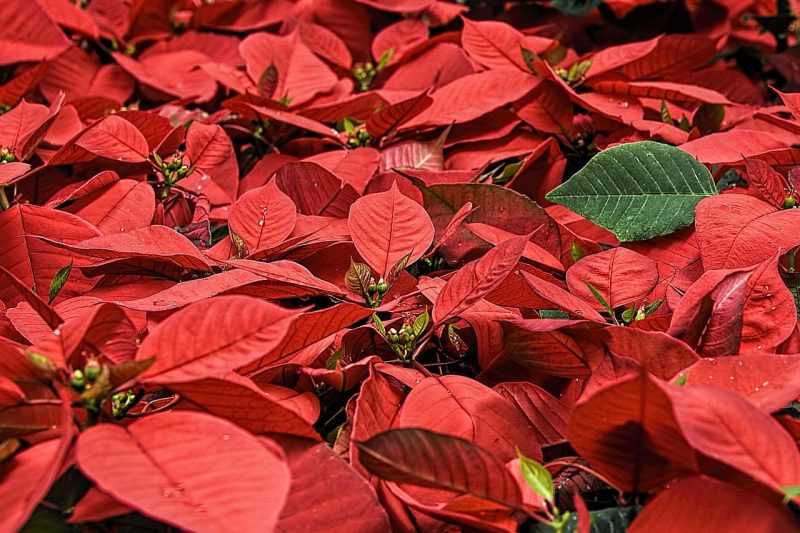If you want to know how to grow poinsettias from seed, it only requires three steps. It would be useful to understand various propagation methods for poinsettias, including starting it from seeds. The good news is that rooting poinsettias from seeds is relatively straightforward.
Those who have a greenhouse also have a headstart in using poinsettia seeds. Remember that most plant seeds require ideal conditions to sprout, and it’s easier to achieve them in a controlled environment indoors. With more than 100 poinsettia varieties, you can also choose which will work the best in your region and preferred gardening practices.

How To Propagate Poinsettias From Seed For Success
Step #1. Pollination and seed collection
To start growing poinsettias from seeds, you need to learn how to collect them yourself. You can always get your seeds from a trusted nursery, but it’ll be advantageous to get them yourself if you have mature plants. It might not sound very easy, but you can actually pollinate the poinsettia flowers yourself.
Remember that poinsettias bloom in winter, and you can help them develop seeds by picking up their pollen using a cotton swab. Just be gentle in brushing and handling the plants, and you should notice green bulbs growing on the stalks. These are the seed pods that you can wait to mature for seed collection.
By the end of the flowering season, the blooms will fade, and the pods will also turn brown. Collect the seed pods and store them in a paper bag for further drying. Place the bags somewhere cool and dry for some time, and you should be ready to pop them open to collect the small dark seeds for sowing.
Step #2. Seed stratification
Another reason why some gardeners refrain from growing poinsettias from seeds is that they require stratification. Remember that some plants need seed stratification to ensure germination, and this is true for poinsettias. You must place the seeds inside the refrigerator for three months before sowing them.
What this does is simulating winter to encourage the seeds to germinate as they would naturally in the wild. You can also check out another cold stratification method to suit what’s comfortable for you. However, some gardeners mentioned that they have successfully sprouted poinsettia seeds even without preparation, so perhaps this requirement varies per species.
Step #3. Planting
Planting poinsettia seeds will then be straightforward, but know that it can take weeks for them to germinate. However, you can ensure success in growing poinsettia seeds in the greenhouse and maintain stable conditions. Sow one seed at a depth of one and half-inch per pot and place the containers somewhere bright but out of direct sunlight.
You want to ensure soil moisture and protect them from harsh temperatures to guarantee to sprout in one to two weeks. According to the University of Vermont Extension, these plants prefer temperatures between 60 to 70°F. Extremely cold conditions and drafts can damage your poinsettias, so it’s best to grow them in the greenhouse where you can control the indoor climate.
How To Transplant Poinsettias
According to the University of Minnesota, the best time to transplant poinsettias is in late spring or early summer. Use a well-draining pot with a mix of soil and peat moss or in the garden with well-draining soil. Ensure that the medium is moist and the plants will get at least four hours of sunlight and then water them thoroughly after transplanting.
Caring And Growing Poinsettias
Location
You can use grow lights to provide the poinsettias their light requirements, but if you’re outdoors, they must receive four to six hours of sunlight every day. The location itself should also provide stable temperatures around 65 to 70°F with some humidity to maintain poinsettias. Extreme dryness, heat, and freezing temperatures will damage the plants.
Water and fertilizer
Always monitor your soil moisture but never overwater the poinsettias. You want to use a well-draining medium and containers to prevent the soil from getting soggy as this can cause root rot. Gardeners often water the plants as needed from January to March.
You can feed your plants when they are actively growing, but make sure to dilute it accordingly. As for maintenance, fertilize every four weeks, but stop during the holidays. An all-purpose houseplant fertilizer would be enough for poinsettias.
Reblooming
Can you get poinsettias to rebloom? The good news is it is possible, but you need to do specific practices. Gardeners notice that you can encourage reblooming by reducing the light for the plants.
Conclusion
There is no other plant that can immediately get you nostalgic for the holidays, like the poinsettia. And the good news is learning how to grow poinsettias from seed is even easy. Don’t be intimidated by the need to pollinate the flowers and stratify the seeds yourself.
As a gardener, it’s best to learn different techniques that you can apply to other plants as well. Start by collecting the seed pods and letting them dry to collect the seeds. Store the seeds in the refrigerator for three months before sowing in the greenhouse.
The advantage of sowing poinsettia seeds in the greenhouse is you can protect them from fluctuating temperatures. This way, you can guarantee germination in one to two weeks. Maintain soil moisture and place the pots somewhere bright to encourage the growth of your plants.
